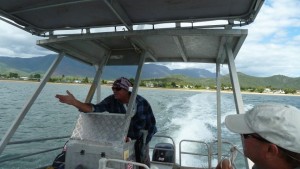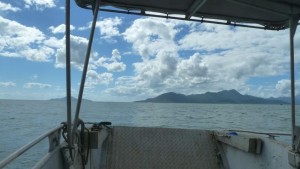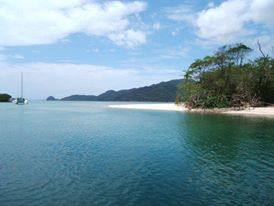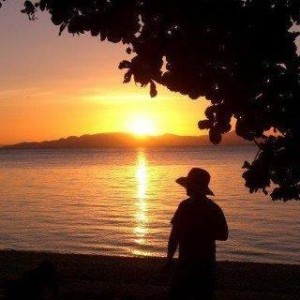Hiking at Hinchinbrook
by Robert de Rooy

About to Board the Boat at Cardwell Beach to Hinchinbrook Island (note the backpacker on the left, he had over 30kgs in his pack!)
We have just completed our 8th hike of the 32km Thorsborne Trail on Hinchinbrook Island. This is something we have done each year since 2010 (we have missed one year) and will continue to do as we all live only about 2.5 hours drive from Hinchinbrook.
This year John, the owner of ‘Absolute North Charters’, asked if we could write a guide to help other hikers better prepare themselves for what lay ahead of them walking the trail. Most information on the web is from hikers who have walked the Thorsborne Trail once only, our information is from 8 years of hiking the Thorsborne Trail on Hinchinbrook island.

Almost at the drop off point on Hinchinbrook
We think we have the trek down to a fine art, 4 or 5 blokes get together each year and we plan, plan some more, refine what we take and then go and do Hinchinbrook Island. I am sure you will not agree with all our ideas/methods, what is important to us may not be important to you, if anything, by reading this guide you might pick up on a few tips to make your hike of Hinchinbrook Island more enjoyable.

The beach at Ramsay Bay, a 5 minute walk after being dropped of in the mangroves with Absolute North Charters
North to South or South to North of Hinchinbrook?
I would guess over 80% of hikers walk North to South, taking the boat from Lucinda through the Hinchinbrook channel or getting picked up by Absolute North Charters off the front beach in Cardwell to begin the trip then leave the Island via Lucinda in the South. We hike North to South for a few reasons, one being that the northern part receives less rainfall and is dryer, so the camps and hike improve as you move south. We think it’s also smarter to walk towards good water sources as well which kick in at north Zoe. The second reason we walk North to South is North Queensland predominantly gets southeasterly winds, this means you will get a breeze on the front of your body rather than on your backpack as you hike. The third reason is the transfer back to the mainland is 10 minutes to Lucinda from George point where we can grab a shower and a MEAL perhaps before heading out. ALSO, Lucinda has better access so if the tide is really low on the day you come off it does not delay you in Lucinda. Cardwell has tidal constraints.
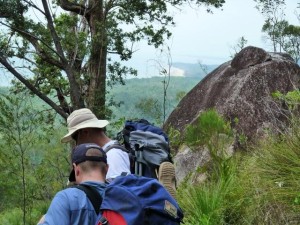
Heading South with a Southeasterly breeze cooling us off
The north facing hills of Hinchinbrook provide zero breeze which also makes you want to climb them a little faster to catch the cool south east breeze on the crest and down the next hill to Hinchinbrook.
What time of year is best?
April to September are the months National Parks suggest you hike the Thorsborne Trail, this year we hiked end of April and our maximum daytime temperatures were still 30 degrees celsius, you will find May to September is more comfortable. Fresh water is easier to find early in the hiking season. The year of Cyclone Yasi in 2011 the Thorsborne Trail was closed for much of the season, we hiked mid October that year and it was very hot and very dry on the island as it was 6 months into the dry season, I recall getting fresh water at Little Ramsay Bay of Hinchinbrook requiring a 400 metre rock hop up the creek to locate running water.
How many days to walk the Thorsborne Trail?
Many hikers walk it in 4 days/3 nights or 5 days/4 nights, we now walk it in 6 days/5 nights. Why? Because once you are on the Island it is just over $5.00 in camp fees per person plus the food/drink we bring. Our first camp Nina Bay is only 1.5 hours from the drop off point, we are carrying the heaviest weight for the trip for a very short time. Most people hiking North to South rush the Northern part of the Island as they don’t have enough nights, Nina Bay is a very pretty bay and campsite.
Suggested stays for a 6 day trip:- 1st night Nina Bay, 2nd night either Little Ramsay Bay or Banksia Bay, 3rd and 4th night Zoe Bay (best place to fish so 2 days is a must), 5th Night Mulligan Falls.
Something to consider when planning your trip is the the high tide on your last day of your hike, a tidal creek on the beach heading down to George Point can only be crossed at low to half tide. We always decide our hiking dates based on the tides on our last hiking day, ideally the low tide should be late morning to early afternoon, 11.30am to 2pm. This means we don’t need to leave Mulligan Falls camp until later in the morning. If the low tide is earlier expect to be leaving Mulligan Falls camp very early on your last day to get down to George Point on time, effectively shortening your time at this wonderful campsite plus not having to rush. Absolute North are local to the area and accordingly are full of local knowledge.
John says 2.3metres will be 4 inches over your knees at the deepest part for about 10 metres of the crossing and the creek will be 25m wide in total.
If you are thinking that you might stay at George Point a night because of early pickup times you will be disappointed, it has no water and is not very attractive, plus if you are only on the Island for 3 nights and 4 days, you will have to walk from Zoe Bay to George on your third day!(15km). We leave Mulligan Falls to arrive at George Point as the boat arrives. You will need about 2 hours to get from Mulligan Falls to George Point, 35 mins to get to the beach and then about 1 hour 15 mins to walk the beach to George Point. You should cross Mulligan creek 30 minutes before the pickup time. Absolute North Charters has a much more regular pickup time at George point to save you spending a night there. 1300hrs or 1pm for those not accustomed to 24hr format.
This allows for a swim before you leave Mulligan and a no rush last day on the Island but gets you off with plenty of time to drive out or get to an airport via shuttle bus.
Another thing we look at when planning is the moon phase during the hike, not so much for fishing but for that extra bit of light around camp at night.
Finally the day you start your hike can have an impact on numbers of people camping at Zoe Bay, we like to start our hike on a Tuesday so we arrive at Zoe Bay on the Thursday afternoon, Zoe Bay attracts boaties on the weekends who can also book and camp swelling the numbers on the Island. We are usually walking out of Zoe Bay on Saturday morning heading for Mulligan Falls…
Booking
If you already have booked your camping permits then all you need to do is book your transfers with John. Click here to book online now.
Best value transfer is right here, Lucinda to Ramsey Bay, PLUS George’s Point to Lucinda – or vice-versa
(outbound plus return)
CLICK HERE to view our current prices
If you have not booked your camping permits click here to open the National Parks booking site, start entering the word ‘Thorsborne’ into ‘Park Name’ and it will show up. You will also be able to see online how many people are hiking the trail for the dates you wish to book
A maximum of 43 people can hike the Thorsborne trail spread out over all the camping sites. We sometimes get a whole site to ourselves. Remember that locals can arrive at Zoe Bay and Mulligan Falls by boat and also camp, usually on weekends which can swell the numbers a little
Once you have your dates booked you can book your transfers on this website here.
If you prefer to use email to book send John an email at info@absolutenorthcharters.com.au
He can give you the “insider tips” for . . .
- Thorsborne Trail Hiking Permits
- Transport: Flights, Train, Bus, Airport Shuttle, Hire Car
- Accommodation – Lucinda and Hinchinbrook Shire
- Ferry Transfers
If you want to feel safer on the island you can pick up an Epirb. It could come in handy. To get one call Cardwell Reef and Rainforest Information Centre on 07 4066 8601 (International +61 7 4066 8601). Mobile phone coverage exists in places (Telstra is best) John can tell you exactly where that phone service is.
PLB and Gas can be obtained directly from Absolute North Charters. Contact John
How much weight?
If you are from overseas backpacking around Australia and wish to hike Hinchinbrook you should consider only taking what you really need, your excess possessions should be offloaded. The first photograph in this guide shows a Belgium backpacker with over 30 kgs on his back about to board the boat, although he was a huge guy he could easily have arranged with John to hold his gear until he had finished the hike.
Weight is something hikers are obsessed with, we are no different except we all enjoy cold beer at the end of our first day and we all like to drink red wine with our evening meals (and beyond), you are now either switching off or getting excited that you can hike Hinchinbrook and still enjoy a few creature comforts.
23kgs is our maximum target weight consisting of lightweight sleeping bags, hammocks, self inflating sleeping mats, minimal clothing and personal items. We leave the Hinchinbrook island on day 6 with 14 to 15 kgs each. Our pack sizes are 70 to 80 litres each and I take a small digital baggage scale to keep everyone honest when repacking packs.

Beers each year on day one at Nina Bay
What gear to take?
We take a communal lightweight fly (see above), this is very handy, a place you can cook eat and sit when it rains. The fly allows us to hang led lighting powered with a lithium battery, we run a 3 watt MR16 led and a 1.5 watt eagle eye led for cooking lasting the entire trip. All found on ebay.
SLEEPING – Most hikers we see on the trail have tents, our preference are personal jungle hammocks weighing about 1.3kgs each, the ones we use are ‘Expedition Asym’ made by Hennessy Hammocks from Canada (now shipped from New Zealand) www.hennessyhammock.com this is the same company who supplied the (Hex Rainfly 70D Polyester) communal fly. The hammocks were about $160.00 each. They have a rain fly, are insect proof and use seat belt webbing (tree huggers) so trees are not damaged. You do need a thin ¾ length self inflating sleeping mat to lie on, otherwise the air movement below the hammock draws the heat away from you body, even in the tropics.

Hammocks are very comfortable, insects and rain can’t get in.
Now 6 years old, our hammocks and still in quite good condition, we use them camping/hiking elsewhere other times of the year other than Hinchinbrook and Thorsborne.
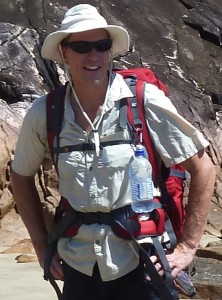
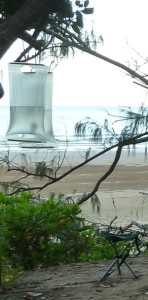
WATER BOTTLES & WATER STORAGE
A 750ml water bottle is all you will need when walking, rarely will you run out of water before the next creek crossing where you can fill up again. However, during the dry periods this amount should be much more (e.g. Oct, Nov, and December)’
No high tech water bottles in our group, just clip a carabiner on a Pump Bottle and you are set. (see photo)
For the camp each night we have 2 ten litre plastic water bladders, filling them to 50% each for the night camp and hanging them with bungee cords.
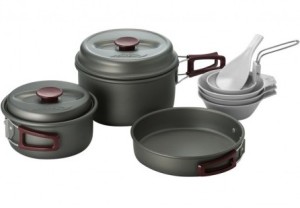
If you consider buying water bladders check if they smell, we bought one once that due to the ‘outgassing’ of the plastic the water is tainted to the point you can’t even drink it.
COOKING – we use a very old aluminium billy can with spout that boils water, cooks soup, rice and pasta.
The cook set we use is a hard anodised set from Kovea bought on ebay from Korea for about $70.00 including delivery. www.kovea.com
This set is strong, brilliant to cook with and is very easy to clean. Hard anodised aluminum is very lightweight also.
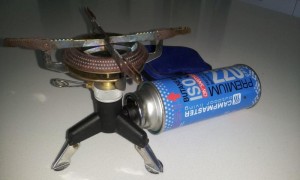 BURNERS
BURNERS
After much testing we believe the ‘CampMaster’ gas in the blue canister burns the best, these cans of gas are just a bit over a dollar a can.
You will need an adapter to allow connection to a burner for these style of gas can. Bother burner and adapter were found on ebay, we have two sets.
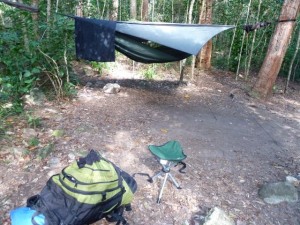 SEATING – The only campsite that has tables/seats is Zoe Bay, each year we take lightweight 3 leg chairs to sit on, they strap to the side of a backpack and only weigh about 500 grams each.
SEATING – The only campsite that has tables/seats is Zoe Bay, each year we take lightweight 3 leg chairs to sit on, they strap to the side of a backpack and only weigh about 500 grams each.
These chairs were bought at Sam’s Warehouse for about $8.00 each.
(Note the tree huggers connecting hammock to trees, national parks do not like ropes to be used for anything as can cause tree damage)

FOOTWEAR
This is where the purists will object. We see most hikers on Hinchinbrook with sturdy hiking boots, we hike the Thorsborne Trail in Crocs (yes, those ugly shoes)…. and for good reason.
When you get to a pristine creek crossing in hiking boots you probably won’t mind walking through the crystal clear water, some people take hiking boots off and then put them back on the other side of the creek crossing, Hinchinbrook has a lot of creek crossings so this does become tedious.
When you get to one of the swamps it is a different story, if the Island has had recent rain some of the swamps have lots of mud, when you encounter these you will appreciate having a pair of Crocs.
Some of us also carry lightweight mesh walking shoes and keep them as a backup strapped to our packs, or you may consider having a pair of Crocs strapped to your pack for those wet sections of the Hinchinbrook island.
You will be amazed at how well Crocs grip, if you find Crocs give the sides of your feet blisters try wearing sweat bands (wrist bands) pulled onto your feet, they work a wonder!
Hey, it’s all about comfort, not fashion!
FISHING

Fishing South Zoe Bay Creek
Telescopic or 3/4 piece rods and lures are a must if you like fishing, the saltwater creeks provide lots of opportunities to catch fish. You are not allowed to fish the freshwater sections of the creeks.
South of the headland at North Zoe Creek you can also fish the beaches/ocean, north of this point is a green zone where ocean/beach fishing is not allowed (at the time of writing, please check with authorities)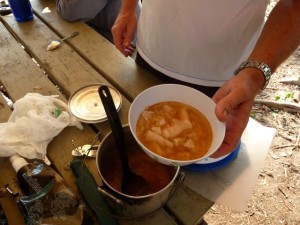
When we do catch fish we fillet/cube the flesh adding it to ‘Hot and Spicy’ Asian packet soup cooked in our trusty billy can.
A great breakfast treat when we can get fish early in the day.
What food we take…
As we all enjoy a cold beer on day one, it is standard that our first night’s meal is Indian ‘Rogan Josh Curry’ served with Basmati rice and wraps, this entire meal weighs 2kgs and is our heaviest meal of the trip, the Rogan Josh is frozen solid days earlier in two zip lock bags. 3 hours before we drive to Cardwell 8 x 500ml cans of beer (1L each when 4 people are hiking) are placed in the freezer to chill them right down, everything cold is then packed into a $2.00 supermarket insulated cooler bag.
Early afternoon we walk into Nina Bay, the beer is still icy cold and the curry is slowly defrosting. 6kgs of extra weight for day one but well worth it, we only had to carry it for 1.5 hours…
BREAKFAST
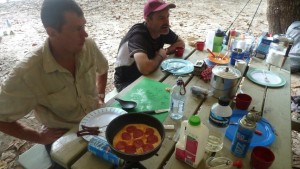 The first morning when we wake up in Nina Bay we like to pack up and walk for about 40 minutes to a headland just before Boulder Bay, a huge boulder on the headland provides morning shade where we fry our bacon (which was packed frozen) and scramble our 8 eggs to eat in a wrap. This day we only need to walk a total of about 2.5 hours if heading to Banksia Bay, even less if stopping at Little Ramsay Bay.
The first morning when we wake up in Nina Bay we like to pack up and walk for about 40 minutes to a headland just before Boulder Bay, a huge boulder on the headland provides morning shade where we fry our bacon (which was packed frozen) and scramble our 8 eggs to eat in a wrap. This day we only need to walk a total of about 2.5 hours if heading to Banksia Bay, even less if stopping at Little Ramsay Bay.
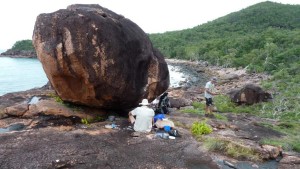 Other mornings we have Weetbix with honey and powdered milk for breakfast, everyone seems to enjoy this. We break it up at some point with a morning of pancakes, the cheap ‘shaker’ pancake mix and as a treat we cut slices of ‘Hans’ long life salami (the one that says eat within 14 days of opening, it does not require refrigeration).
Other mornings we have Weetbix with honey and powdered milk for breakfast, everyone seems to enjoy this. We break it up at some point with a morning of pancakes, the cheap ‘shaker’ pancake mix and as a treat we cut slices of ‘Hans’ long life salami (the one that says eat within 14 days of opening, it does not require refrigeration).
If we are lucky to catch fish before breakfast then it is hot and spicy soup boiled up in the billy can.
LUNCH
We usually arrive on the island on day one at about 11am in the morning, having stopped at ‘SubWay’ before getting to Cardwell, on arrival at the island we walk for about 1 hour and leave our packs at the saddle near Nina’s Peak, a 15 minute climb to the base of Nina’s Peak provides a great view and ideal place for our ‘Subway’ lunch.

Enjoying SubWay and the 180 degree views halfway up Nina’s Peak
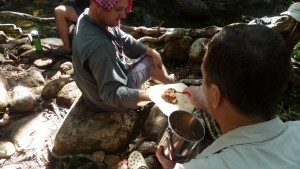 Most lunches are wraps with a tinned tuna mix at one of the many creek crossings, Sole Mare brand of Tuna is popular.
Most lunches are wraps with a tinned tuna mix at one of the many creek crossings, Sole Mare brand of Tuna is popular.
Tuna and Beans or Tuna Paella in a wrap, it is quick and easy, open 3 tins, mix it up in a pot and then dish it out.
DINNER
For each of our 6 trips night one is always Rogan Josh curry with Basmati Rice and wraps, my wife Anna loves cooking indian curries and this is a very traditional version with lots of spices, cardamom pods etc. A real hit with the guys and great ice bricks to keep the beer cold.
Pasta and Rice are our bases for most meals, we have experimented with different meals over the years.
Popular meals are:-
 Red Chicken Curry with Jasmine rice and bamboo shoots
Red Chicken Curry with Jasmine rice and bamboo shoots
At Woolworths you can buy ‘Select’ cubed chicken breasts in 340 gram tins, two of these with a tin of bamboo shoots, two 50 gram packs of powdered coconut milk and two packets of Mae Ploy Red Curry Paste. 2 packets of curry paste are required to give the meal a bit of a kick, I also take along a small plastic bottle of vegetable oil to fry the curry paste in.
The secret is to put the chicken breast chunks in at the end just to heat through, otherwise they will break down.
The rice we cook using the absorption method, I have a small mesh bag to put the rice in where we drop it into a freshwater stream, just like running rice under the tap to remove the starch.
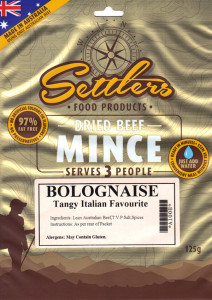 Spaghetti Bolognaise
Spaghetti Bolognaise
A chap called Neville Solomon in Brisbane is a butcher who makes dehydrated beef mince meals and they are quite good value. Of his range his Spaghetti Bolognaise is our favourite, we get him to send us 250 gram packs which when rehydrated makes about 1 kg of mix.
One packet of spaghetti and a packet of Kraft grated parmesan cheese completes the meal.
This stuff will last for years, go to www.settlersfoods.com.au to order.
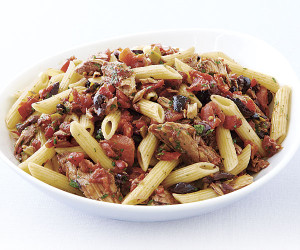 You will need to search a recipe for this one, tinned tuna, capers, kalamata olives, anchovies, tinned tomatoes and penne pasta.
You will need to search a recipe for this one, tinned tuna, capers, kalamata olives, anchovies, tinned tomatoes and penne pasta.
Very tasty meal, we also bring dried chill for those who like it with a bite.
Tuna Mornay is another that we cook.
DRINKS
In addition to the beers on day one we also like to take red wine, the first year it was two casks of wine, lucky we had some sticky tape with us as the bladders kept springing leaks. These days we buy bottled wine and transfer it to plastic soft drink or water bottles. Our wine quota is 500ml per person per night with our main meals and the games of cards that follow. That is 10kgs of red wine for 4 of us over 5 nights, or a bit over 13 bottles of red.

Listening to NRL State of Origin at Banksia Bay with a card game

Crackers, Dip and carefully measured cups of red wine
HIGHLIGHTS AND TIPS FOR WALKING THE THORSBORNE TRAIL
BITING INSECTS
You are going to encounter Midge’s (Sandflies) and Mosquitoes during your hike, if you enjoy fishing you are going to encounter them more than usual, in particular the Midge’s as shown below.

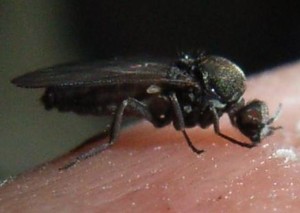
If leaving from Lucinda or Cardwell be sure to use insect repellent before you get dropped off as you are dropped off at a pontoon in the mangroves, we use Tropical Aeroguard, Tropical Off or Bushman’s Deet. Atomiser pump bottles or if using deet the stuff in the tube, and be sure to bring plenty. We have seen some hikers covered in bites, easily avoided if repellant is applied before arriving in areas where biting insects reside and breed.
If your shirt is not tucked in be sure to use repellant above your belt line as the little buggers also get under your shirt.
With Midge’s you usually won’t know you have been bitten until you see the red marks, start scratching them and they will get more itchy and they can also get infected.
Not all areas of Hinchinbrook have Midge and mozzie problems, walking the beaches, hills and a lot of the inland trails are insect free. It is the mangrove areas and the saltwater creek mouths that are the worst. Banksia Bay Camp and Zoe Bay Camps will require repellant at all times.
ANIMALS
We usually encounter at least one snake each year while hiking, we stop walking and let them slowly pass.
At Zoe Bay camp sites you may have the odd Monitor Lizard (Goanna) enter your camp looking for scraps, in particular any fish scraps. Do not try to catch one as they will bite you, something we are not keen on proving!
Rat proof boxes are in place in all campsites for storage of food, these are to stop white tail rats eating through your packs to get to your food. We have seen one white tail rat in our 6 years, more common are the fawn-footed melomys, a cute little marsupial the size of a very large mouse/small rat, these are seen mostly at Mulligan Falls campsite.
This year we had a few Melomys racing up and down one of our packs, we were convinced we had every bit of food safely stored in the rat proof box and these little marsupials where just putting an entertaining show for us, we were all having a bit of a chuckle and took a few photos, within 30 seconds one had chewed a hole the size of a 20 cent piece though the pack and devoured half a forgotten muesli bar.
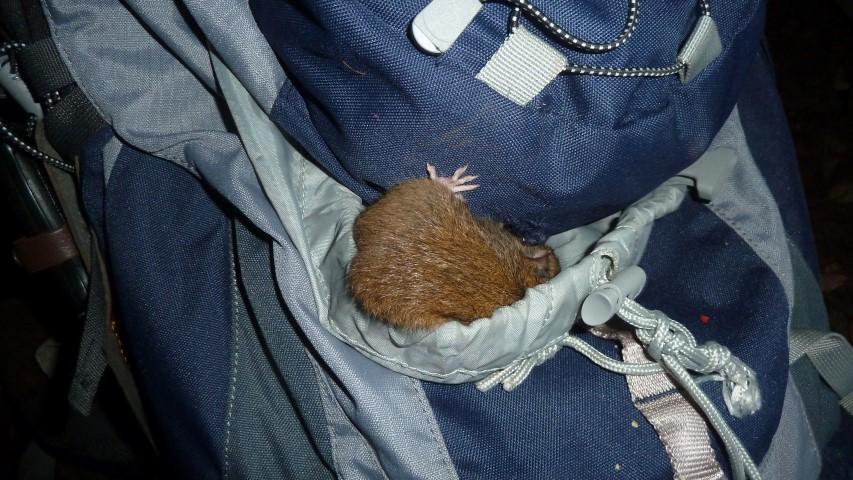
A Melomy makes short work chewing through a backpack to get to a forgotten muesli bar.
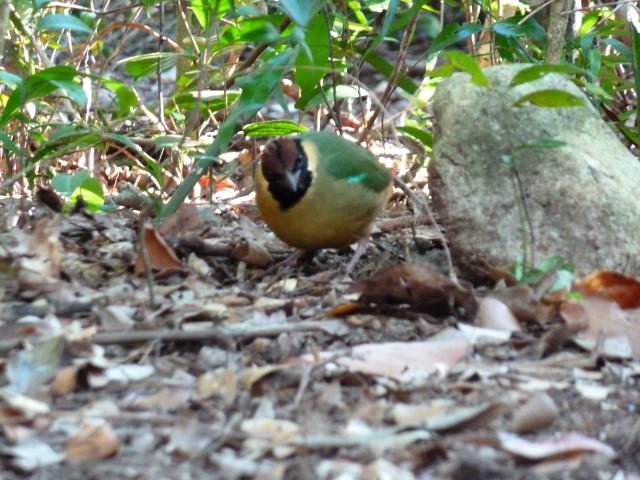
A Noisy Pita at our camp Mulligan Falls. They have a unique call, ‘Walk to Work’.
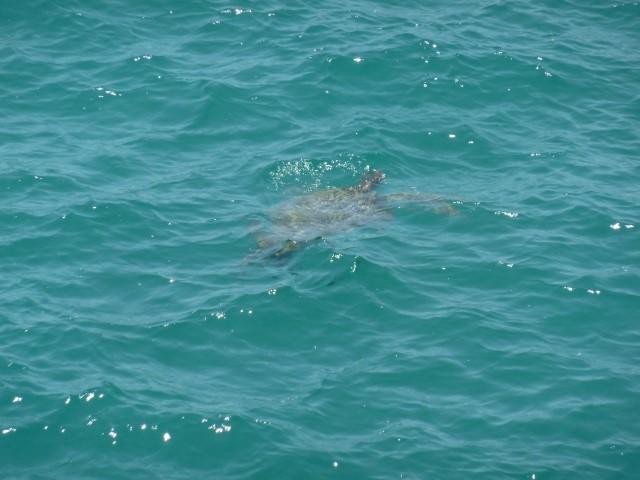
At Boulder Bay you may see large green sea turtles and reef sharks at the northern headland.
CAMPSITES AND SURROUNDS
Nina Bay has a drop toilet and two areas to camp, you can get fresh water at a creek 200m before you get to Nina Bay campsite or at the creek at the southern end of the beach.

Nina Bay
A track to the left between the toilet and the beach takes you to a second secluded campsite with a rat proof box, the site is about 3 metres above the beach and is one of our favourite places to camp. The creek 100m north of this site should contain fish, although we have not had much luck over the years.
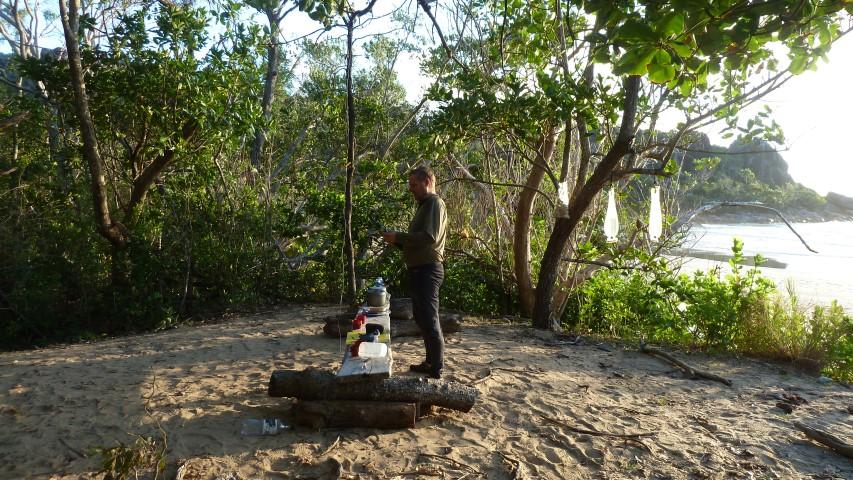
Setting up Camp at Nina Bay (note the water bladders hanging with bungee cords)
Little Ramsay Bay is about 1.5 hours walk from Nina Bay, Boulder Bay (no campsite) is about midway and we have usually breakfast here at the northern end. We have camped at Little Ramsay only once in our 6 years, we usually top up our water bottles here at the creek and continue on to Banksia Bay.
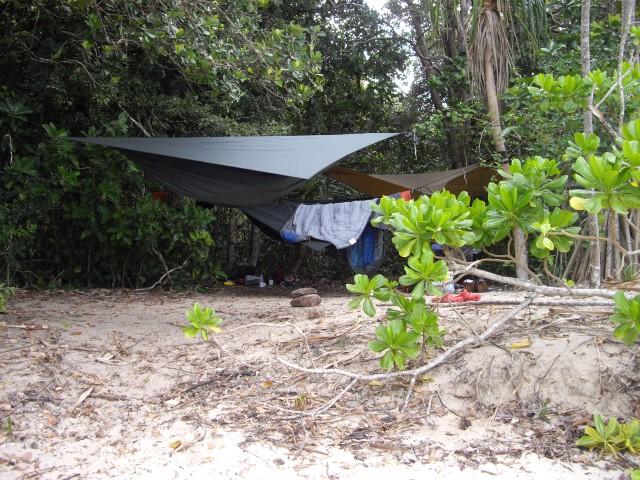
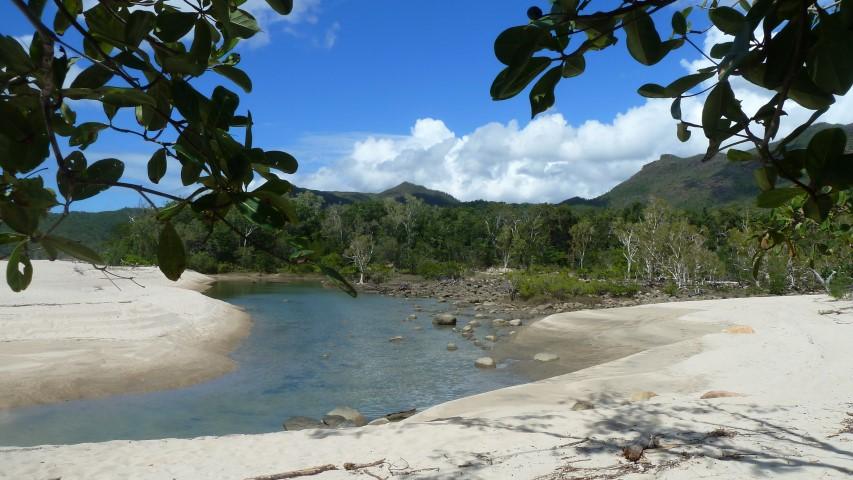
Little Ramsey Bay has less mosquitoes and less Midges compared to Banksia Bay. It also has a drop toilet.
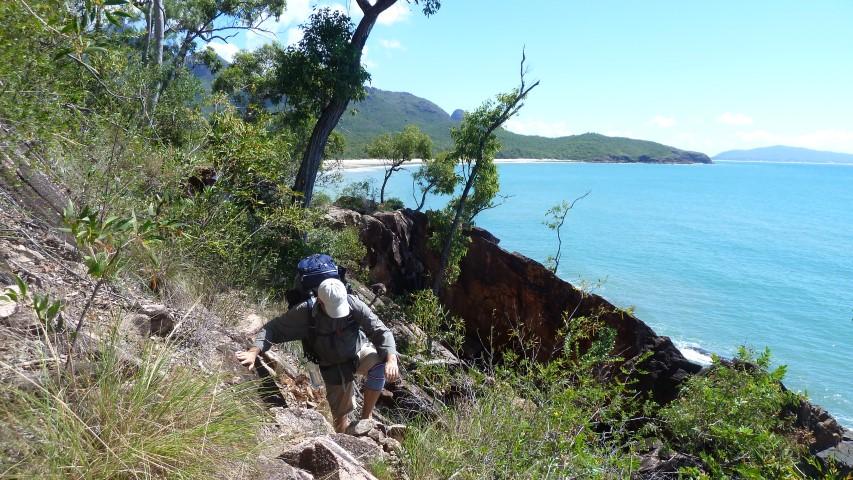
Little Ramsay Bay in the background as we navigate the headland to Boulder Bay.
Banksia Bay is about 1 hours walk from Little Ramsay Bay, no fresh water (unless you want to work for it upstream of the creek in the swamp), it also does not have a toilet, it does have a rat proof box.
We like Banksia Bay as we usually have it to ourselves due to the lack of facilities and the fact you need to walk down to it for 800m off the main track. After setting up camp we hike back to the main track and then another 400m southwards to get water, have lunch and a swim at the top of Banksia Creek.
Zoe Bay – The walk from Little Ramsay Bay or from Banksia Bay is the longest section of the trip, 4 or 5 hours depending on where you camped the night before. The terrain and vegetation is forever changing and is quite an easy hike.
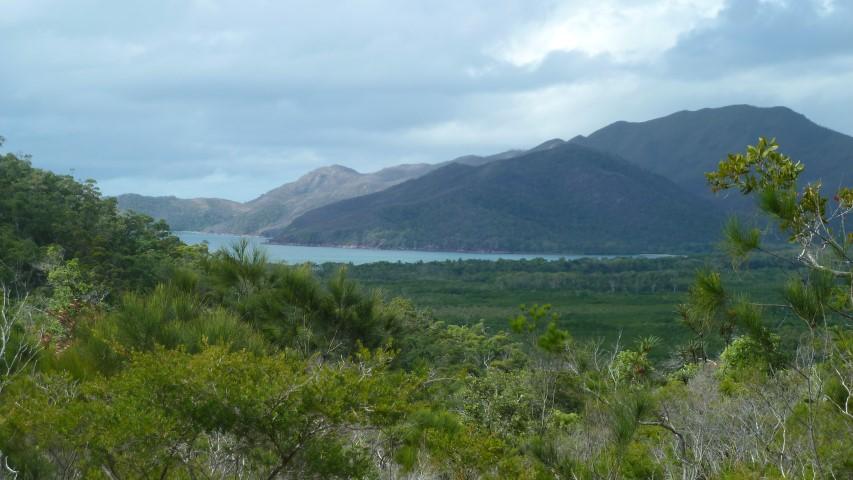
About 1 hours out from Banksia Bay you will see Zoe Bay, 3 hours to go
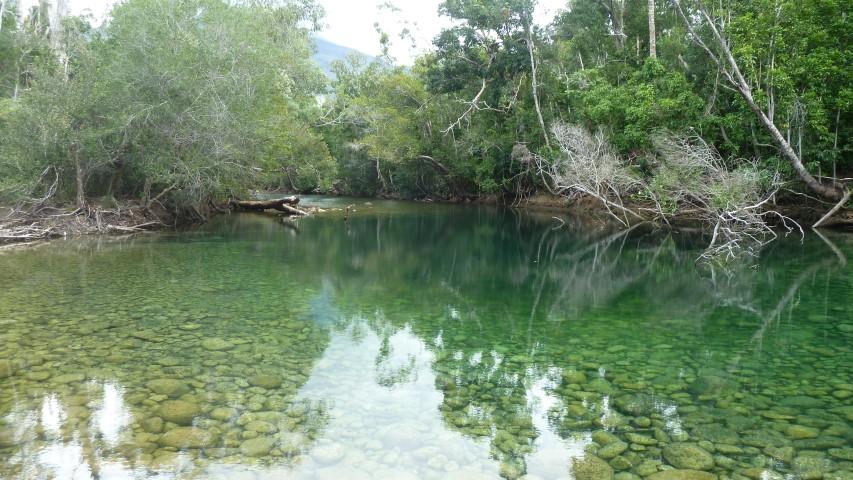
Inland – North Zoe Creek where freshwater meets saltwater
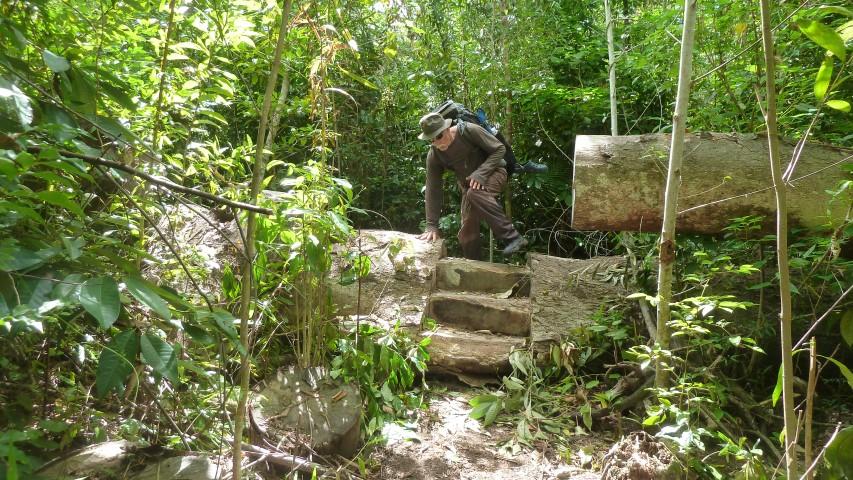
Cyclone YASI February 2011 caused a lot of damage to vegetation inland from Zoe Bay.
National Parks created steps for hikers in some fallen trees. Photo April 2015
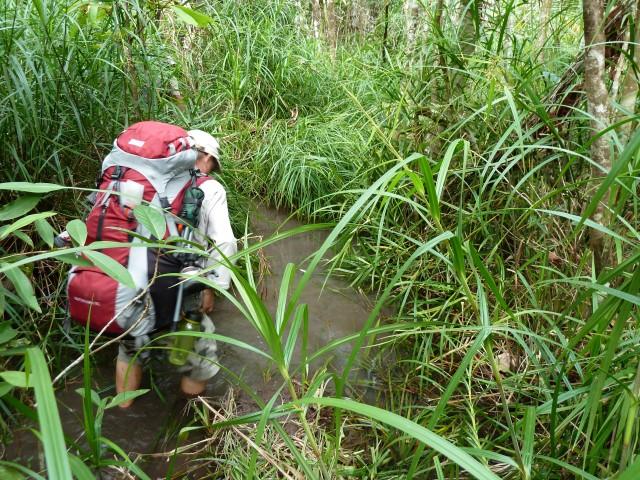
If you have had a decent wet season the swamps can be interesting. This is July 2012
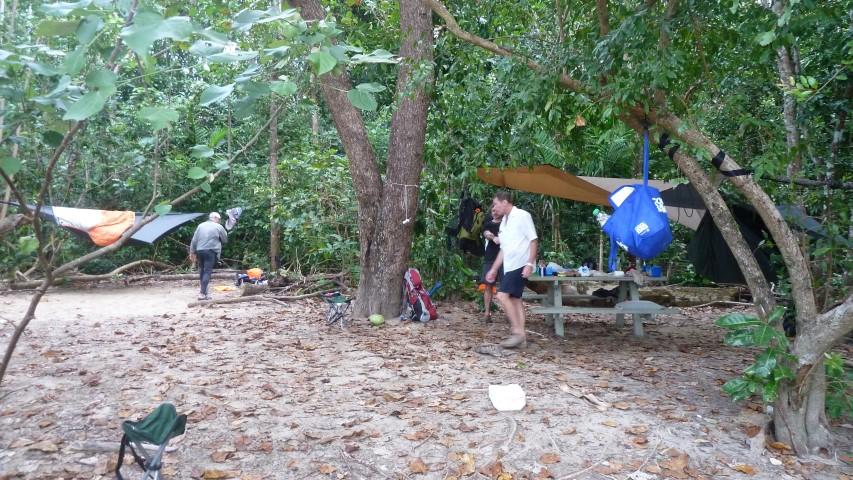
Setting Up Camp at Zoe Bay
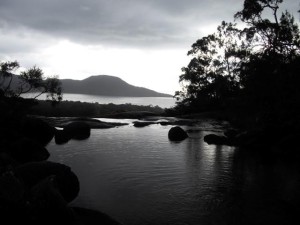
Zoe Falls and above Zoe Falls
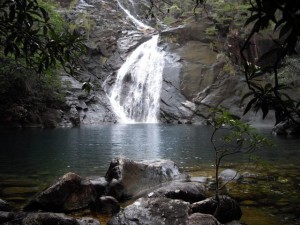
Mulligan Falls
The walk from Zoe Bay to Mulligan Falls is about 4 hours, the top of Zoe Falls is a highlight for views, we sometimes stop there for breakfast. You will come to a turnoff before Diamantina Creek to Sunken Reef Bay, this is a steep descend for 1km and we have heard you sometimes need to wade through deep water near the beach to get to the campsite. We have never walked to it. Diamantina Creek is about 3.5 hours into the 4 hour walk towards Mulligan Falls, a good rest stop for a snack, 30 mins later you will be at Mulligans.
The first year we arrived at Mulligan Falls we did not like the camping area at all, it was as if a cyclone had gone through, the trees had lost many leaves, we opted to camp down near the creek down at the beach that year.
It was only when we were on the southern boat that we learnt someone had slipped down the falls and been rescued by helicopter, the downdraft from the helicopter had defoliated the trees. Mulligan Falls has many warning signs to stay off the falls and the area above the falls, yet people still climb them!
You can camp at Mulligan Falls one night only. It has a drop toilet and rat proof boxes.
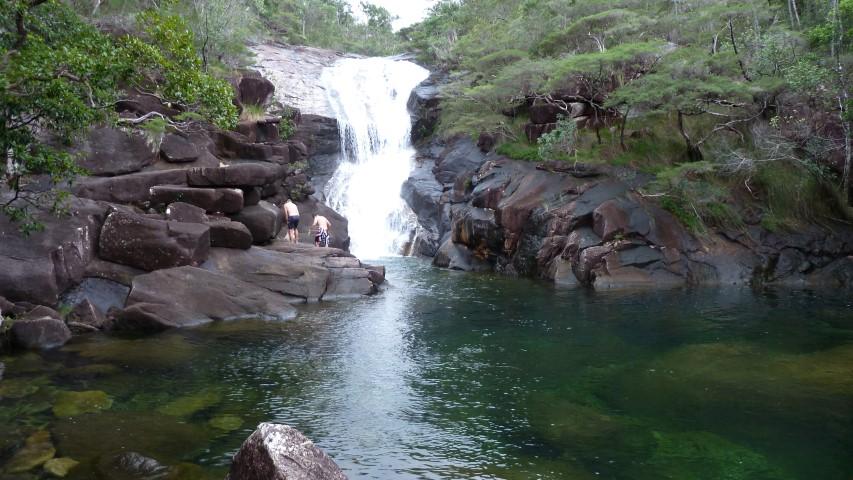
Mulligan Falls, large Jungle Perch fish are found in all large bodies of fresh water on Hinchinbrook
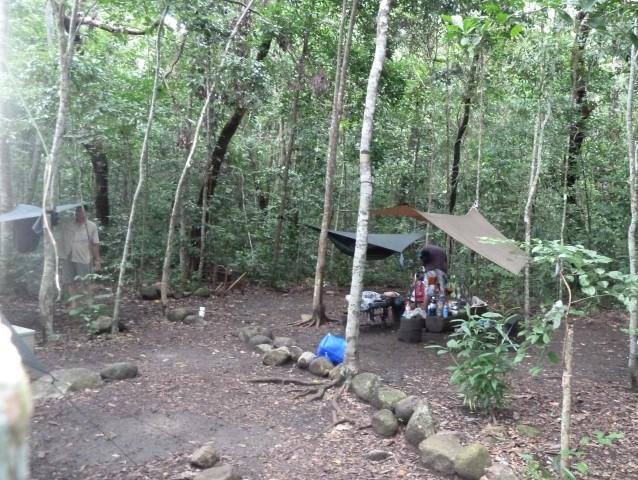
One of the many campsites near Mulligan Falls
From Mulligan Falls to the beach is a 35 minute hike, you will cross a few creeks before hitting the beach and these will be your last fresh water on the island. Once on the beach it is just over an hour to George Point to catch the boat back to the mainland at Lucinda.
The Thorsborne Trail will amaze you as well as challenge you, take the time to visit Hinchinbrook Island, the Memories will last a lifetime.
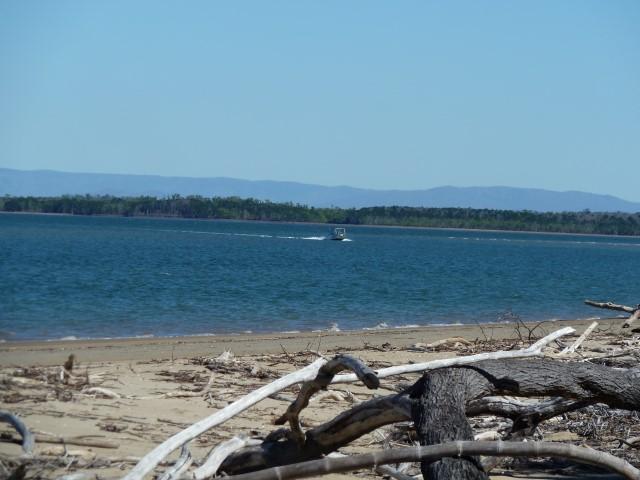
At George Point, ferry is coming to pick us up.
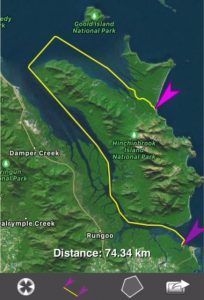
Lucinda to Ramsay Bay
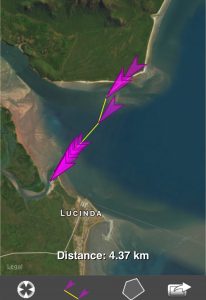
George Point to Lucinda
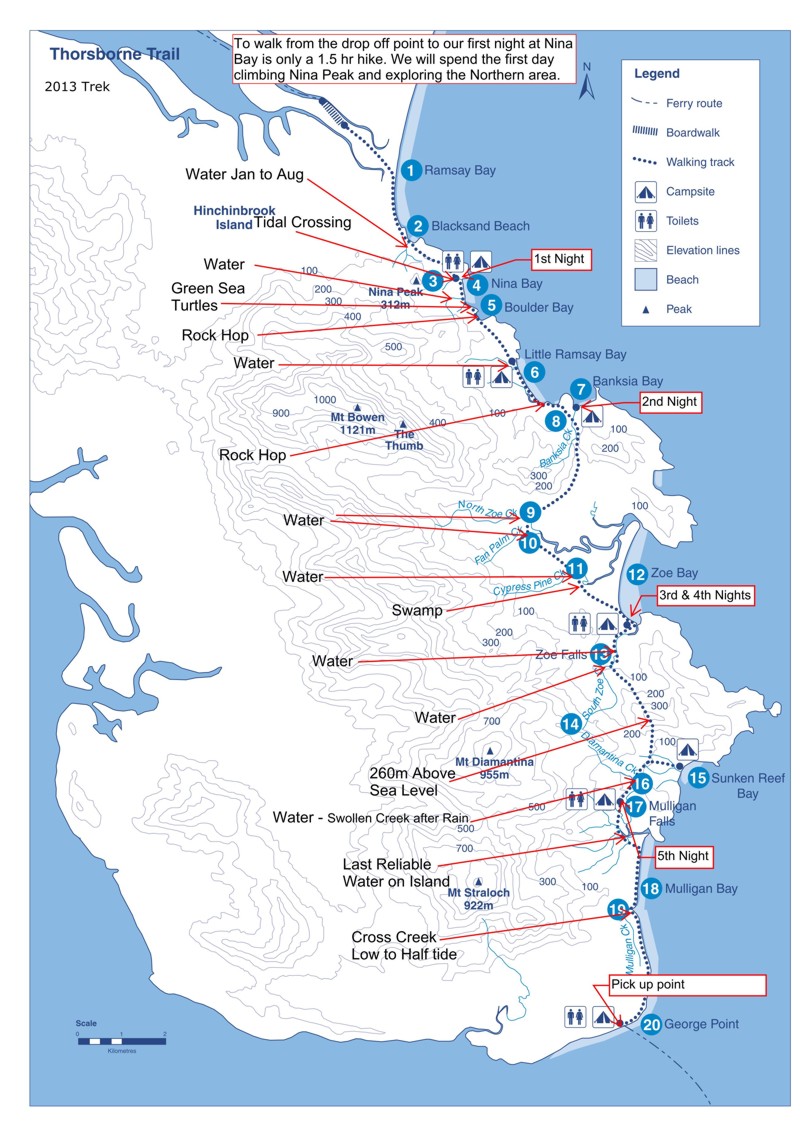
National Parks map with our notes
Important Notice
Don’t forget, you can book your transfers on this website here.

